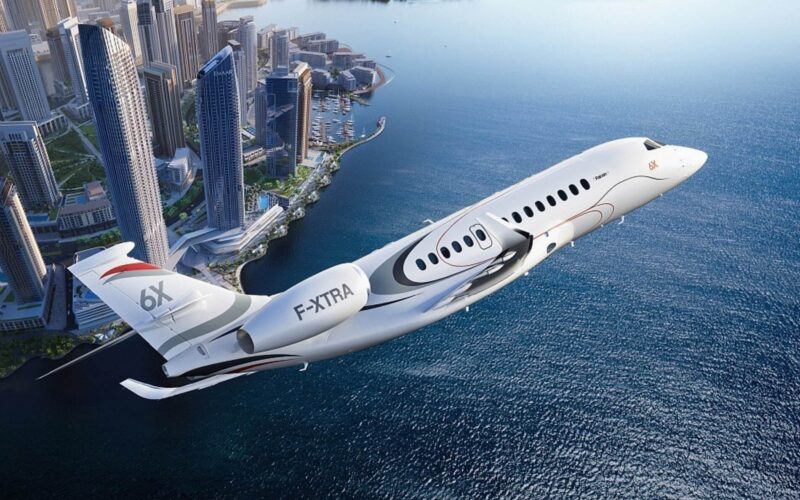Article written by Rytis Beresnevičius and Clément Charpentreau
As Dassault rolls out the Falcon 6X business jet, will it be the jet that changes the game in business aviation? The French aircraft manufacturer definitely hopes and anticipates so, as the Falcon 6X is set to become the first twin-business jet that it has developed and plans to release into service since the Falcon 2000. Previously, Dassault wanted to develop the Falcon 5X – a program that ended in controversy and subsequently, birthed the Falcon 6X.
The French planemaker promised to deliver a redefined business jet travel experience with its newest design. While the Falcon 6X was announced after the controversial cancellation of the Falcon 5X, Dassault did indicate in a story in FlightGlobal that the newest jet is a “major redesign” rather than a slightly changed 5X. So, what will be included in this ‘redefined travel experience’?
Focus on passenger experience
While manufacturers like to focus on various characteristics for a jet, Dassault seemingly went all-in on the passenger experience in order to lure in clients.
The French manufacturer boasts about the fact that the Falcon 6X is the tallest and widest in the business aviation sector. The stats do not lie, as the Falcon 6X has a cabin height of 1.98 meters (78 inches), while its main competitors, the Bombardier Global 7500 and the Gulfstream G650, have a cabin height of 1.88 meters (74 inches) and 1.91 meters (75 inches), respectively. In terms of width, the 6X once again comes out on top with a width of 2.58 meters (102 inches), while the Global 7500 and the G650 are as wide as 2.44 meters (96 inches) and 2.49 meters (98 inches).
The innovations in PaxEx continue, with a cabin pressurized to match the air at 3,900 feet when the aircraft is cruising at FL41. Falcon Connect, Dassault’s own connectivity solution for passengers to be able to work while flying will also be offered to the 6X’s owners, allowing them to access an “all-in-one suite of services and applications.” The wing, specially designed to smoothen any turbulences, is equipped with a flaperon (a hybrid of flap and aileron), a control surface usually used in larger commercial planes. It gives the 6X additional controlling edge during the approach.
Seemingly, Dassault is trying to compensate for the operational disadvantages of the Falcon 6X. Both the Bombardier Global 7500 and the Gulfstream G650 can travel much further and cruise much faster in order to sustain the long-range reach of the jet. At the same time, both Bombardier and Gulfstream jets are already in service. Entering the market in an economic downturn due to the pandemic might prove a challenge for Dassault’s newest business jet. That was not the company’s initial plan, as the Falcon 5X was scheduled to enter service in H1 2017. But problems with the development of the jet’s engine of choice put an end to it.
The Silvercrest and 5X debacle
In October 2013, Dassault Aviation announced their choice of the Safran Silvercrest to power their upcoming Falcon 5X. Initially, the engine was expected to be delivered for flight tests late in the same year. But because of recurring difficulties in the development of the Silvercrest, delivery was postponed to the end of 2017.
The delay forced Dassault to defer the introduction of the Falcon 5X by 3 years, to 2020. “This slippage has caused customers’ concerns and order cancellations (12 in 2016),” the manufacturer noted. In the meantime, Textron Aviation also picked the engine for the Cessna Citation Hemisphere, three years after Dassault, in October 2016.
On July 5, 2017, the Falcon 5X took to the skies with provisional engines. Despite the difference in power specifications, the aircraft met the manufacturer’s expectations. But in autumn 2017, a few months before the new delivery deadline, Safran notified Dassault that it encountered new problems with the high-pressure compressor of the Silvercrest. This new complication would mean that, once again, the Falcon 5X entry into service would have to be delayed by a year.
On December 13, 2017, Dassault Aviation eventually pulled the plug. “Considering the magnitude of the risks involved both on the technical and schedule aspects of the Silvercrest program, Dassault Aviation initiates the termination process of the Silvercrest contract leading to the end of the Falcon 5X program and plans to start negotiations with Safran,” the manufacturer announced.
In the same statement, Dassault Aviation said it began discussing the launch of a new business jet, using the same fuselage diameter as the 5X but this time powered by Pratt & Whitney Canada. On February 28, 2018, the Falcon 6X was unveiled.
On September 6, 2018, Dassault reached an amicable settlement with Safran, in which the engine manufacturer committed to pay a compensation of €230 million ($280 million) to the planemaker. After Textron Aviation terminated the Hemisphere program citing similar concerns in 2019, the Safran Silvercrest remains without customers.
Different time and place
With the Silvercrest rout behind, the Falcon 6X will finally appear in front of the eyes of Dassault’s customers and employees. Shades of the 5X will still be visible on the newest business jet, which will enter a much different world of business aviation in 2022. The French manufacturer plans to conduct the first flights with the type, powered by Pratt & Whitney’s PW812D, in 2021. The 6X will carry a price tag similar to that of its stillborn predecessor, around $47 million. Its main competitors have a much steeper price, as the Global 7500 is estimated to cost around $72 million, while Gulfstream has priced the G650 at around $69 million.
The cheaper price tag could be a major factor during the COVID-19 crisis, as companies look to cut their expenses as much as possible. The Falcon 6X is still a fairly capable jet with passenger experience features that Dassault is very happy to boast about.

